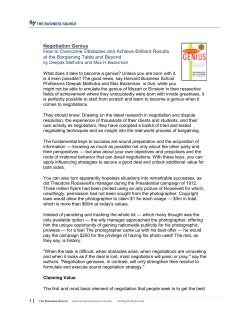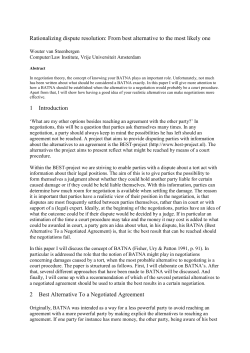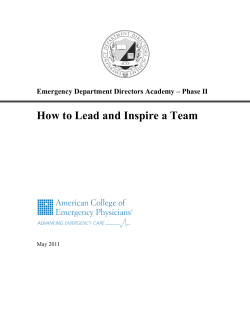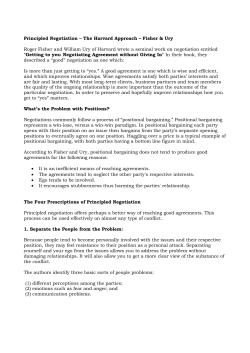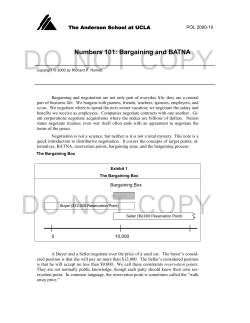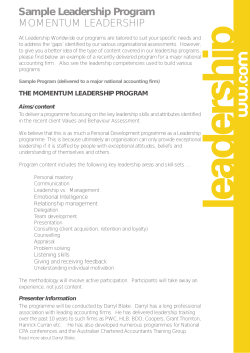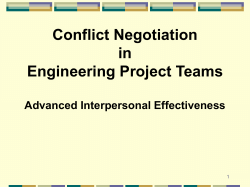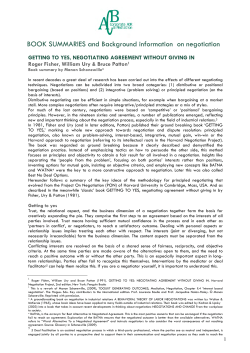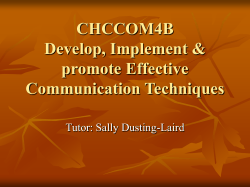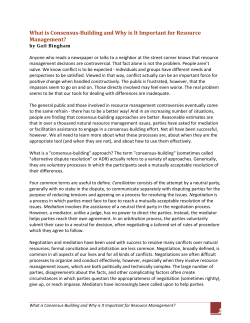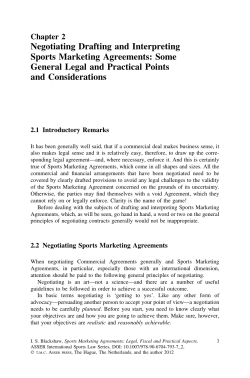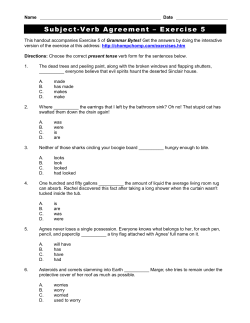
Getting to Yes. Negotiating agreement without giving in. ... Hutchinson Business, 1982
Getting to Yes. Negotiating agreement without giving in. Roger Fisher and William Ury, Hutchinson Business, 1982 Summary by Valerie Iles in 2004 This is a great book that is still worth reading in full. Negotiation: 1. Should produce a wise* agreement 2. should be efficient 3. should improve or at least not damage the relationship between the parties. *Wise : meets the legitimate interests of each side to the extent possible; resolves conflicting interests fairly; is durable; and takes community interests into account. The tendency is to bargain over positions but this doesn’t enable wise agreements: they are compromises and do not meet all the interests, it isn’t efficient, it isn’t fair in that success often goes to the harder player; and it puts the substance of the negotiation and the relationship between the negotiators in conflict. So if you don’t want to bargain over positions then you have to change the rules of the game so that you negotiate instead on the merits. This involves: a. People – separate the people from the problem. See yourselves as working side by side on the problem. Separate the relationship from the substance – deal directly with the people problem: Perception – ‘understanding the other side’s thinking is not simply a useful way to solve your problem’. Stop thinking that their thinking is the problem –focus instead on what is the difference between your thinking and theirs. Put yourself in their shoes. Don’t deduce their intentions from your fears. Don’t blame them for your problem –even if blame is justified it is counter-productive. Describe symptoms (e.g. the machine you service has broken down three times this month on x and y dates, in this manner…..). Discuss each other’s perceptions. If their perceptions of you are wrong, look for opportunities to act inconsistently with their perceptions – and thus change them. Give them a stake in the outcome by making sure they participate in the process. Our instinct is to do the opposite – wait until it is all sorted out before we ask the most ‘difficult’ person for their input. Make your proposals consistent with their values – principles, past words and deeds. Emotion – recognise and understand emotions, theirs and yours. Make emotions explicit and acknowledge them as legitimate. Allow the other side to let off steam – control your impulse to interrupt polemical speeches. Don’t react to emotional outbursts – could even agree to adopt a rule that only one person is allowed to be angry at a time. Communication – three big problems with communication: 1. Sides may be talking to own constituents or to observers rather than to each other. 2. One or other side may not be listening. 3. Misunderstanding. Therefore: Listen actively and acknowledge what is being said: Pay close attention, ask them to spell out exactly what they mean, request that ideas be repeated if there is ambiguity or uncertainty. Do not phrase a response while listening. Summarise their position “Let me see whether I follow this from your point of view…”. Understanding is not agreeing, so state their case positively. Speak to be understood. Speak about yourself and not about them. (Especially about their motives etc). Speak for a purpose – only say what needs to be said . Build a working relationship. Benjamin Franklin did it by asking to borrow a book. Chat. Face the problem, not the people.: “Look we’re both…… . Unless we try to satisfy both our interests we are unlikely to reach an agreement that will work…. Let’s look at how we can meet both … “ . Sit on the same side of the table, look at the same map/chart/….. . b. Interests – focus on interests not on positions For every interest there are usually a number of positions that would satisfy. Also behind opposing positions lie many shared and compatible interests as well as conflicting ones. So ask “why?” why have they asked for that? and ask “why not?” why have they not accepted my proposal? what interests of theirs stand in the way. Remember the most powerful interests are basic human needs. Talk about interests – make your interests come alive, and acknowledge their interests as part of the problem. Put the problem before your answer. Look forward not back. Be concrete but flexible – mention a figure but indicate there is some scope for agreement. Be hard on the problem and soft on the people – give positive support to the human beings in the same measure as you emphasize the problem. c. Options – invent options for mutual gain. Generate a variety of possibilities before deciding what to do. Give yourself /selves time to do this, so that you don’t feel under pressure to come a solution in the presence of your ‘adversary’. People involved in a negotiation rarely sense a need for options – they believe they know the right answer. There are four major obstacles to inventing an abundance of options: 1. Premature judgement. So: separate the act of inventing options from judging them – try brain-storming. Rules for brain storming – define your purpose, chose a few participants, change the environment, design an informal atmosphere, choose a facilitator. Then seat people side by side facing the problem; clarify the ground rules including the no-criticism rule, brainstorm, and record the ideas in full view. Then star the most promising ideas, invent improvements for these, set up a time to evaluate and decide. Consider brainstorming with the other side. 2. Searching for the single answer. Look instead for a range of options. There are four basic steps to inventing options: 1.State the problem – what’s wrong, what are current symptoms, what are disliked facts contrasted with a preferred situation? 2. Analysis – diagnose the problem: sort symptoms into categories, suggest causes, observe what is lacking, note barriers to resolving the problem. 3.Approaches – what are possible strategies or prescriptions, what are some theoretical cures, generate broad ideas about what might be done. 4.Action ideas – what might be done, what specific steps might be taken to deal with the problem? Look through the eyes of different experts to generate new ideas. Invent agreements of different strengths – something you really want, and then perhaps an agreement to refer to an arbitrator or to look for best practice…. 3. Assumption of fixed pie. Look for mutual gain. Identify shared interests. Dovetail differing interests ( e.g. of, Jack Sprat). i.e. Look for items that are of low cost to you and of high benefit to them. Analyse differences; are they differences of interest, belief, value placed on e.g. time, different forecasts, different attitude to risk? To help you identify their wishes, ask for their preferences – devise a list of options equally acceptable to you and ask them which they prefer. It is these differences that will let you be Jack Sprat and his wife. 4. Thinking that ‘solving their problem is their problem’. It isn’t it’s yours too. So put yourself in their shoes; let them know the consequences of their preferred options but not in a threatening way; help make their decision easy. d. Criteria – insist the result be based on some objective standard. This prevents the hard player winning through being more insistent. How do you develop objective criteria and how do you use them when negotiating? You can use fair standards or fair procedures. Fair standards. You will usually find more than one objective criterion available. It must be independent of each side’s will, be legitimate and be practical. Fair procedures e.g. two children cutting a cake. Frame each issue as a joint search for objective criteria (you want x, I want y, lets see if we can agree a way to find a fair…) Ask for their reasoning behind their figure etc, see if you can use that reasoning to agree a process. Reason and be open to reason. Never yield to pressure. Keep other issues separate – never concede on one issue to gain on another. Pressure can take many forms – a bribe, a threat, a manipulative appeal to trust, or a refusal to budge. Invite them to state their reasoning, suggest objective criteria you think you can apply, refuse to budge on this basis – never yield to pressure only to principle. If the other side will not budge then and will not give you a persuasive basis for their position you have a choice - take it or leave it. What if they are more powerful? No magic but you can 1. Protect yourself against making an agreement you should reject Could set a bottom line. And this will protect you from a really lousy deal, but there are some downsides – you can’t use what you learn in the negotiation about the other side, so you may have set it too high, you may also inhibit yourself from developing other options. Instead know your BATNA (best alternative to a negotiated agreement). The reason you negotiate is to get something better than you can get without negotiating. So be clear about what you get without negotiating – the cost of renting accommodation, bridging loans etc if trying to sell a house. Make sure you exceed your BATNA . Formulate a trip wire – in excess of your BATNA , and take a rain check when you reach that. 2. Help yourself make the most of your assets to get as good an agreement as possible. The better your BATNA the greater your power. So know your BATNA, develop your BATNA: invent a list of actions you could conceivably take, improve on some of the more promising ones, and select the best. Consider the other side’s BATNA. You may be able to lower their expectations if your view of their BATNA is different from theirs. The more easily and happily you can walk away from a negotiation the greater your capacity to affect its outcome. What if they won’t play? Focus on what you can do. Don’t attack their position, look behind it. Don’t accept or reject it, treat it as one possible option, assume it’s genuine and try to work to improve it by discussing with them what would happen if it were accepted. Don’t defend your ideas, invite criticism and advice. Recast an attack on you as an attack on the problem. Ask questions and pause. Do not make statements. Reframe as questions. Use the one-text technique – do what a third party would do – make a list of all the needs (theirs and yours) and come up with a first proposal for how to meet all of those needs, explicitly inviting criticism, then a second, third etc. At some point you will have to say ‘well that’s the best I can do, so we will have to accept this or leave it’. What if they use dirty tricks? Most people either put up with it –vow never to deal with them again or give them the benefit of the doubt, or they respond in kind. Instead:1. recognise the tactic 2.raise the issue explicitly 3. question the tactic’s legitimacy and desirability. But remember to separate the people from the problem – don’t attack them personally for using itquestion the tactic not them. Focus on interests not the positions – so if they are taking an extreme position in the press –‘why are you…? are you trying to protect yourself from criticism…’. Invent options for mutual gain – ‘shall we agree no statements to the press until we …’. Insist on objective criteria- ‘I know that you’re in a rush to get to your next meeting – let’s hold some items over for another meeting tomorrow’. Remember your BATNA. Tricky tactics come in three kinds: deliberate deception – misrepresentation of facts (separate people from the problem – unless you have good reason to trust someone, don’t. Get supporting evidence), authority (if only you have authority to make concessions then only you will make concessions – so check before you meet what authority people have – or reserve the right to review the agreement yourself if they are going to have that right) or intentions (build compliance features into the agreement). psychological warfare - If you find the physical surroundings make you want to rush the negotiation then say so. If they make personal attacks recognise it as part of the negotiation, raise it. Recognise good guy bad guy routines, do not yield to threats, be very careful when making them , they can easily increase resistance. Positional pressure –e.g. If they try escalating demands – adding something else every time you think you have reached agreement, ask for a break so that you don’t respond on impulse, call it to their attention, Insist on principle. e.g. If their ‘partner’ won’t agree recognise it as a tactic, talk to the partner. Don’t be a victim. Ask yourself: if a full account of what I said and did were published in the press would I be embarrassed? For summary table see next page. Summary: Negotiation behaviours Problem – should I play hard or soft? Soft Participants are friends The goal is agreement Make concessions to cultivate the relationship Be soft on the people and the problem. Trust others Change your positions easily. Make offers. Disclose your bottom line Hard Participants are adversaries The goal is victory Demand concessions as a condition of the relationship Be hard on the problem and on the people. Distrust others Dig in to your position. Accept one-sided losses to reach agreement. Search for the single answer: the one they will accept. Insist on agreement. Try and avoid a contest of will. Make threats Mislead as to your bottom line. Demand one-sided gains as the price of agreement. Search for the single answer: the one you will accept. Insist on your position. Try and win a contest of will. Yield to pressure. Apply pressure. Solution – change the game and negotiate on merits Principled Participants are problemsolvers The goal is a wise outcome reached efficiently and amicably Separate the people from the problem Be soft on the people and hard on the problem Proceed independent of trust. Focus on interests not on positions Explore interests. Avoid having a bottom line. Invent options for mutual gain. Develop multiple options to choose from; decide later. Insist on objective criteria. Try and reach a result based on standards independent of will. Reason and be open to reasons, yield to principles, not pressure.
© Copyright 2025
